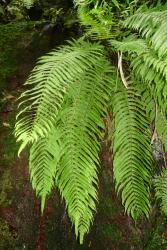Terrestrial ferns. Rhizomes erect or suberect, scaly. Rhizome scales ovate, thin, appressed, entire. Fronds monomorphic. Stipes scaly. Laminae 1-pinnate to 1-pinnate-pinnatisect, herbaceous, several pairs of proximal pinnae gradually or abruptly reduced in size; basal pinnae auricled acroscopically; aerophores absent; abaxial surface of laminae bearing a few ovate scales, short acicular hairs, and sometimes a few capitate hairs, or ± glabrous; sessile spherical glands absent. One or more basal veins from adjacent pinna lobes uniting below the sinus. Sori round, exindusiate; paraphyses absent. Sporangia lacking hairs. Spores monolete, with many wings.
Allan (1961) included all indigenous New Zealand species of Thelypteridaceae within a broadly construed Thelypteris. Holttum (1971, 1973) re-circumscribed the genus Pneumatopteris, and included P. pennigera from New Zealand and south-east Australia in it, albeit as an atypical member with ovate scales on the abaxial surface of the costae when young, the abaxial surface of the lamina not pustular when dry, indusia lacking, and no glands or hairs on the sporangia (Holttum 1977). However, Fawcett et al. (2021) showed that species attributed to Pneumatopteris occurred in multiple lineages, and that Holttum’s concept was highly polyphyletic. The New Zealand and Australian plant resolved on a long, isolated branch sister to the rest of the christelloid clade, and Fawcett & Smith (2021) described the new genus Pakau to accommodate this anomalous species. In New Zealand, the genus is distinguished from Macrothelypteris by its 1-pinnate-pinnatifid laminae and much shorter lamina hairs, from Christella and Cyclosorus by its lack of indusia, from Cyclosorus and Thelypteris by its erect rhizome, and from Pseudophegopteris by the basal pair of veins in adjacent pinna segments joining below the sinus, rather than being free.
A monotypic genus confined to New Zealand and south-eastern Australia (Fawcett & Smith 2021). One non-endemic species in New Zealand.
| Category | Number |
|---|---|
| Indigenous (Non-endemic) | 1 |
| Total | 1 |
The base chromosome number in Pakau is x = 36 (Brownlie 1954, as Cyclosorus pennigerus; Fawcett & Smith 2021).




